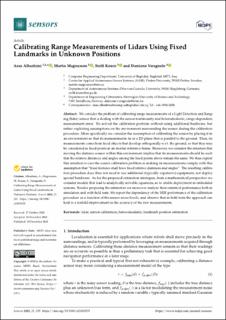| dc.description.abstract | We consider the problem of calibrating range measurements of a Light Detection and Ranging (lidar) sensor that is dealing with the sensor nonlinearity and heteroskedastic, range-dependent, measurement error. We solved the calibration problem without using additional hardware, but rather exploiting assumptions on the environment surrounding the sensor during the calibration procedure. More specifically we consider the assumption of calibrating the sensor by placing it in an environment so that its measurements lie in a 2D plane that is parallel to the ground. Then, its measurements come from fixed objects that develop orthogonally w.r.t. the ground, so that they may be considered as fixed points in an inertial reference frame. Moreover, we consider the intuition that moving the distance sensor within this environment implies that its measurements should be such that the relative distances and angles among the fixed points above remain the same. We thus exploit this intuition to cast the sensor calibration problem as making its measurements comply with this assumption that “fixed features shall have fixed relative distances and angles”. The resulting calibration procedure does thus not need to use additional (typically expensive) equipment, nor deploy special hardware. As for the proposed estimation strategies, from a mathematical perspective we consider models that lead to analytically solvable equations, so to enable deployment in embedded systems. Besides proposing the estimators we moreover analyze their statistical performance both in simulation and with field tests. We report the dependency of the MSE performance of the calibration procedure as a function of the sensor noise levels, and observe that in field tests the approach can lead to a tenfold improvement in the accuracy of the raw measurements. | en_US |

